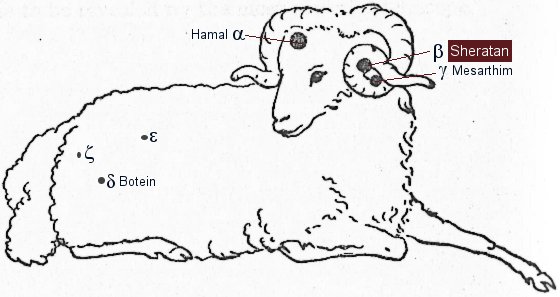The fifth constellation Ptolemy made famous was the constellation Aries: the ram. Obviously, this constellation is still recognized by modern astronomers. For the story of the constellation Aries, we have to go back to the Argo Navis: the ran the constellation resembles was the very same ram that carried the young king Phrixos to the palace of Helios before he could be killed in a plot by his step-mother.
The myth of the ram with the golden wool is part of the myth of Iásōn. Phrixos (Φρίξος) was the son of Athamas, king of Boiotia, and Nephele (a goddess of clouds). His twin sister Helle and he were hated by their stepmother, Ino. So hated, in fact, that Ino burned the local crops and asked for an oracular message to see if the Theoi were angry at her husband's people. She bribed the messengers to tell her husband that the Theoi were, indeed, angry at him. To appease Them, Phrixos and Helle had to be sacrificed. Pious Athamas did as he was told, but just before they could be killed, a ram with golden wool appeared by order of Nephele, and carried the children off.
The ram flew over the ocean and Helle looked down. Spooked by the height, she fell off of the back of the ram, leading to her death. The stretch of water she fell into was called the Hellespontos (Ἑλλήσποντος), literally 'Sea of Helle', a narrow strait in northwestern Turkey connecting the Aegean Sea to the Sea of Marmara. It was later renamed Dardanellia (Δαρδανέλλια).
The ram, unfortunately did not get to live a long, healthy life. As soon as the ram delivered Phrixos to the palace of King Aeëtes--the son of the sun god Helios--on Colchis, it was sacrificed to Zeus. It's golden fleece was hung from a tree in a sacred grove of Ares, guarded night and day by a dragon that never slept. Iásōn eventually slew the dragon with Mēdeia's help and took the fleece back to Iolkos. The ram, after being sacrificed, was placed into the sky by Zeus.
The constellation Aries is visible at latitudes between +90° and −60° and is best visible at 21:00 (9 p.m.) during the month of December.
-
Sunday, January 10, 2021
astronomy Constellation series Helle Iásōn Mēdeia Mythology 101 Nephele Phrixos Ptolemy


No comments:
Post a Comment